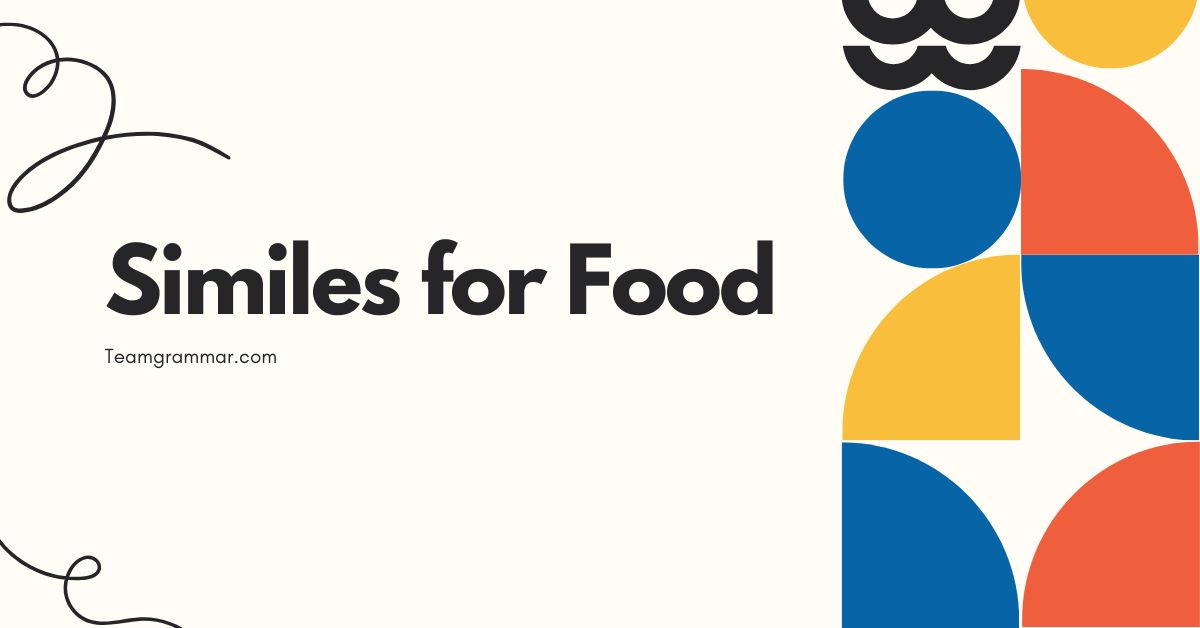44 Similes for Food: A Delicious Dive into Descriptive Language
Similes are powerful tools in the English language, allowing us to paint vivid pictures with words. When describing food, similes can elevate our descriptions from the mundane to the mouthwatering.
Understanding how to use similes effectively not only enhances our writing and speaking but also deepens our appreciation for the nuances of language. This article will explore the world of similes related to food, providing a comprehensive guide for anyone looking to enrich their culinary vocabulary and descriptive skills.
Whether you are a student, a writer, or simply a food enthusiast, this exploration will offer valuable insights and practical examples to help you master the art of using similes to describe the delectable world of food.
Table of Contents
- Introduction
- Definition of Simile
- Classification
- Function
- Contexts
- Structural Breakdown of Similes
- Key Elements
- Common Patterns
- Types and Categories of Food Similes
- Taste Similes
- Texture Similes
- Appearance Similes
- Smell Similes
- Examples of Food Similes
- Taste Similes Examples
- Texture Similes Examples
- Appearance Similes Examples
- Smell Similes Examples
- General Food Similes Examples
- Usage Rules for Similes
- Clarity and Relevance
- Originality and Creativity
- Cultural Sensitivity
- Common Mistakes with Food Similes
- Avoiding Cliches
- Inaccurate Comparisons
- Overuse of Similes
- Practice Exercises
- Exercise 1: Complete the Simile
- Exercise 2: Identify the Simile
- Exercise 3: Create Your Own Similes
- Advanced Topics in Food Similes
- Similes vs. Metaphors
- Similes and Personification
- Similes and Hyperbole
- Frequently Asked Questions
- Conclusion
Definition of Simile
A simile is a figure of speech that directly compares two different things, using the words “like” or “as.” It is a powerful tool used to create vivid imagery, emphasize certain qualities, and make writing more engaging. Similes help readers or listeners understand a concept by relating it to something familiar.
Essentially, a simile bridges the gap between the known and the unknown, making descriptions more accessible and memorable.
Classification
Similes fall under the broader category of figurative language, specifically figures of comparison. They are distinct from metaphors, which imply a direct equivalence rather than a comparison.
Similes can be further classified based on the type of comparison they make – for example, comparing appearance, taste, texture, or smell.
Function
The primary function of a simile is to enhance description. By drawing a comparison, similes can make abstract ideas more concrete and relatable.
They also add depth and richness to writing, making it more appealing to the senses. In the context of food writing, similes can evoke specific tastes, textures, and aromas, allowing readers to almost experience the food themselves.
Contexts
Similes are used across various contexts, from literature and poetry to everyday conversation and advertising. In literature, they are used to create atmosphere, develop characters, and convey complex emotions.
In advertising, they are used to make products more appealing and memorable. In everyday conversation, similes can add color and humor to our speech.
Structural Breakdown of Similes
Understanding the structure of a simile is crucial for using it effectively. A typical simile consists of two main components: the subject being described and the object it is being compared to, connected by the words “like” or “as.”
Key Elements
The key elements of a simile include:
- The subject: The thing being described.
- The comparative word: Either “like” or “as.”
- The object of comparison: The thing the subject is being compared to.
- The shared quality: The characteristic that the subject and object have in common.
Common Patterns
The most common patterns for similes are:
- Subject + “like” + object of comparison: The soup was like sunshine in a bowl.
- Subject + “as” + adjective + “as” + object of comparison: The cake was as light as a feather.
Types and Categories of Food Similes
Food similes can be categorized based on the sensory aspect they emphasize: taste, texture, appearance, and smell. Each category offers a unique way to describe food, appealing to different senses and creating a more complete sensory experience.
Taste Similes
Taste similes focus on the flavor of the food. They compare the taste of a dish to something else that has a similar flavor profile.
These similes are particularly effective in conveying the nuances of taste, such as sweetness, sourness, bitterness, or savoriness.
Texture Similes
Texture similes describe the physical feel of the food in the mouth. They compare the texture of a dish to something else that has a similar feel, such as smoothness, crunchiness, softness, or chewiness.
These similes help readers imagine the tactile experience of eating the food.
Appearance Similes
Appearance similes focus on the visual aspects of the food. They compare the color, shape, or overall appearance of a dish to something else that looks similar.
These similes are useful for creating a visual image of the food in the reader’s mind.
Smell Similes
Smell similes describe the aroma of the food. They compare the smell of a dish to something else that has a similar scent.
These similes can evoke strong memories and emotions, as smell is closely linked to the limbic system in the brain.
Examples of Food Similes
Here are some examples of food similes, organized by category, to illustrate how they can be used to enhance descriptions.
Taste Similes Examples
The following table provides examples of similes that describe the taste of food, using comparisons to familiar flavors and sensations.
| Simile | Explanation |
|---|---|
| The lemonade was as tart as a lemon. | Describes the sourness of the lemonade. |
| The honey was like liquid gold on my tongue. | Emphasizes the sweetness and richness of the honey. |
| The chili was as fiery as dragon’s breath. | Highlights the intense spiciness of the chili. |
| The chocolate was like a velvety dream. | Conveys the smooth, rich, and indulgent taste of the chocolate. |
| The cheese was as sharp as a knife. | Describes the pungent and strong flavor of the cheese. |
| The soup was like a warm hug on a cold day. | Evokes the comforting and soothing taste of the soup. |
| The coffee was as bitter as disappointment. | Highlights the strong and unpleasant taste of the coffee. |
| The salsa was like a burst of sunshine in my mouth. | Conveys the fresh, bright, and flavorful taste of the salsa. |
| The candy was as sweet as a child’s smile. | Emphasizes the pure and delightful sweetness of the candy. |
| The vinegar was as acidic as battery acid (use with caution for effect). | Highlights the extremely sour and sharp taste of the vinegar. |
| The mint was like a breath of fresh air. | Describes the cool and refreshing taste of the mint. |
| The spices were as exotic as a far-off land. | Conveys the unique and complex flavors of the spices. |
| The gravy was as savory as a Thanksgiving feast. | Highlights the rich and satisfying taste of the gravy. |
| The dessert was like a symphony of flavors. | Emphasizes the harmonious combination of different tastes in the dessert. |
| The broth was as bland as water. | Describes the lack of flavor in the broth. |
| The sauce was as smooth as silk. | Conveys the luxurious and refined taste of the sauce. |
| The curry was as pungent as old socks (use with caution for effect). | Highlights the strong and sometimes overpowering smell and taste of the curry. |
| The fruit was as juicy as a summer rain. | Emphasizes the refreshing and succulent taste of the fruit. |
| The herbs were like a garden in my mouth. | Conveys the fresh and aromatic taste of the herbs. |
| The wine was as dry as the desert. | Describes the lack of sweetness in the wine. |
| The salt was like tiny crystals on my tongue. | Emphasizes the distinct and sharp taste of the salt. |
| The coffee was as strong as an ox. | Highlights the potent and robust flavor of the coffee. |
| The dish was as balanced as a tightrope walker. | Conveys the perfect harmony of flavors in the dish. |
| The beer was as hoppy as a bunny farm. | Highlights the distinct hoppy taste of the beer. |
| The cake was as decadent as a king’s ransom. | Emphasizes the rich and indulgent taste of the cake. |
| The tea was as delicate as a butterfly’s wing. | Conveys the subtle and nuanced taste of the tea. |
| The meat was as gamey as a wild animal. | Highlights the strong and earthy taste of the meat. |
| The bread was as yeasty as a brewery. | Describes the distinct and slightly tangy taste of the bread. |
Texture Similes Examples
The following table provides examples of similes that describe the texture of food, using comparisons to familiar tactile sensations.
| Simile | Explanation |
|---|---|
| The mashed potatoes were as smooth as silk. | Describes the creamy and velvety texture of the mashed potatoes. |
| The bread was as hard as a rock. | Highlights the firm and unyielding texture of the bread. |
| The jelly was like a wobbly tower on the plate. | Emphasizes the soft and unstable texture of the jelly. |
| The steak was as chewy as an old boot. | Highlights the tough and difficult-to-chew texture of the steak. |
| The meringue was as light as air. | Describes the delicate and airy texture of the meringue. |
| The ice cream was as creamy as a dream. | Conveys the rich and smooth texture of the ice cream. |
| The crackers were as crisp as autumn leaves. | Highlights the crunchy and brittle texture of the crackers. |
| The pudding was like velvet on the tongue. | Emphasizes the smooth and luxurious texture of the pudding. |
| The noodles were as slippery as eels. | Describes the smooth and easily sliding texture of the noodles. |
| The tofu was as spongy as a bath loofah. | Highlights the soft and porous texture of the tofu. |
| The rice was as fluffy as clouds. | Describes the light and airy texture of the rice. |
| The crust was as flaky as a winter snowstorm. | Emphasizes the delicate and layered texture of the crust. |
| The soup was as thick as mud. | Highlights the dense and heavy texture of the soup. |
| The cake was as moist as a rainforest. | Describes the soft and damp texture of the cake. |
| The chips were as crunchy as gravel. | Highlights the hard and noisy texture of the chips. |
| The caramel was as sticky as glue. | Describes the adhesive and clinging texture of the caramel. |
| The meat was as tender as a baby’s cheek. | Emphasizes the soft and easily chewable texture of the meat. |
| The salad was as crisp as a fresh morning. | Conveys the fresh and slightly firm texture of the salad. |
| The vegetables were as stringy as yarn. | Highlights the tough and fibrous texture of the vegetables. |
| The sauce was as runny as water. | Describes the thin and watery texture of the sauce. |
| The pastry was as brittle as glass. | Emphasizes the delicate and easily broken texture of the pastry. |
| The yogurt was as thick as a wall. | Describes the heavy and dense texture of the yogurt. |
| The cookie was as crumbly as sand. | Highlights the easily broken and grainy texture of the cookie. |
| The bread was as airy as a balloon. | Conveys the light and porous texture of the bread. |
| The skin was as tough as leather. | Highlights the strong and resilient texture of the skin. |
| The candy was as hard as a diamond. | Describes the firm and unyielding texture of the candy. |
| The risotto was as creamy as it gets. | Emphasizes the rich and smooth texture of the risotto. |
| The toast was as dry as bones. | Highlights the lack of moisture and crisp texture of the toast. |
Appearance Similes Examples
The following table provides examples of similes that describe the appearance of food, using comparisons to familiar visual elements.
| Simile | Explanation |
|---|---|
| The tomatoes were as red as rubies. | Describes the vibrant red color of the tomatoes. |
| The sauce was as thick as blood. | Highlights the dark red color and viscous consistency of the sauce. |
| The cake was like a golden sun on the table. | Emphasizes the bright yellow color and appealing shape of the cake. |
| The grapes were as plump as little balloons. | Describes the round and full appearance of the grapes. |
| The lemons were as bright as sunshine. | Highlights the vibrant yellow color of the lemons. |
| The salad was like a rainbow on a plate. | Conveys the colorful and varied appearance of the salad. |
| The soup was as clear as crystal. | Describes the transparent and pure appearance of the soup. |
| The cookies were like little brown buttons. | Emphasizes the small and round shape of the cookies. |
| The frosting was as white as snow. | Describes the pure white color of the frosting. |
| The olives were as black as night. | Highlights the dark black color of the olives. |
| The peppers were as green as emeralds. | Describes the vibrant green color of the peppers. |
| The bread was as brown as a bear. | Emphasizes the dark brown color of the bread. |
| The juice was as orange as a sunset. | Highlights the bright orange color of the juice. |
| The dessert was like a work of art. | Describes the visually appealing and elaborate presentation of the dessert. |
| The peas were as small as beads. | Highlights the tiny size of the peas. |
| The carrots were as orange as a tiger. | Describes the bright orange color of the carrots. |
| The smoothie was as colorful as a carnival. | Emphasizes the vibrant and varied colors of the smoothie. |
| The pie was like a rustic masterpiece. | Conveys the visually appealing and slightly imperfect appearance of the pie. |
| The salad was as vibrant as a spring garden. | Highlights the fresh and colorful appearance of the salad. |
| The noodles were as shiny as silk. | Describes the glossy and smooth appearance of the noodles. |
| The cake was like a tower of deliciousness. | Emphasizes the impressive height and appealing appearance of the cake. |
| The sauce was as glossy as glass. | Describes the shiny and reflective appearance of the sauce. |
| The bread was as golden as the sun. | Highlights the warm and appealing color of the bread. |
| The fruit was as ripe as it could be. | Conveys the appealing and ready-to-eat appearance of the fruit. |
| The spread was as smooth as butter. | Highlights the creamy and even appearance of the spread. |
| The meal was as appetizing as can be. | Describes the overall appealing and inviting appearance of the meal. |
| The food presentation was like a symphony of colors. | Emphasizes the harmonious combination of different colors in the food presentation. |
| The herbs were as green as a forest. | Describes the vibrant green color of the herbs. |
Smell Similes Examples
The following table provides examples of similes that describe the smell of food, using comparisons to familiar aromas and scents.
| Simile | Explanation |
|---|---|
| The coffee smelled like a morning promise. | Describes the inviting and energizing aroma of the coffee. |
| The bread smelled as yeasty as a brewery. | Highlights the distinct and slightly tangy aroma of the bread. |
| The soup was like a warm hug on a cold day. | Emphasizes the comforting and soothing aroma of the soup. |
| The spices smelled as exotic as a far-off land. | Describes the unique and complex aromas of the spices. |
| The bacon smelled as crisp as autumn leaves. | Highlights the savory and slightly smoky aroma of the bacon. |
| The pie smelled like grandma’s kitchen. | Conveys the comforting and nostalgic aroma of the pie. |
| The garlic smelled as pungent as a skunk (use with caution for effect). | Describes the strong and sometimes overpowering aroma of the garlic. |
| The roast smelled like a holiday feast. | Emphasizes the rich and festive aroma of the roast. |
| The cinnamon smelled as warm as a fireplace. | Describes the cozy and inviting aroma of the cinnamon. |
| The lavender smelled as calming as a spa. | Highlights the soothing and relaxing aroma of the lavender. |
| The lemons smelled as fresh as a spring breeze. | Describes the clean and invigorating aroma of the lemons. |
| The seafood smelled as briny as the ocean. | Emphasizes the salty and marine aroma of the seafood. |
| The chocolate smelled as rich as a king’s fortune. | Highlights the decadent and luxurious aroma of the chocolate. |
| The herbs smelled like a summer garden. | Describes the fresh and aromatic scents of the herbs. |
| The cheese smelled as strong as old socks (use with caution for effect). | Highlights the pungent and sometimes unpleasant aroma of the cheese. |
| The fruit smelled as sweet as honey. | Describes the sugary and delightful aroma of the fruit. |
| The curry smelled as spicy as a dragon’s lair. | Emphasizes the intense and pungent aroma of the curry. |
| The bread smelled as toasty as a bonfire. | Highlights the warm and slightly smoky aroma of the bread. |
| The vanilla smelled as comforting as a mother’s hug. | Describes the warm and soothing aroma of the vanilla. |
| The mint smelled as refreshing as a mountain stream. | Emphasizes the clean and invigorating aroma of the mint. |
| The rosemary smelled as earthy as a forest floor. | Highlights the natural and grounding aroma of the rosemary. |
| The truffles smelled as luxurious as a perfume shop. | Describes the rich and sophisticated aroma of the truffles. |
| The ginger smelled as zesty as a lemon grove. | Highlights the sharp and invigorating aroma of the ginger. |
| The basil smelled like an Italian garden. | Conveys the fresh and aromatic scent of the basil. |
| The lavender smelled as soothing as a lullaby. | Highlights the calming and relaxing aroma of the lavender. |
| The garlic smelled as inviting as a cozy kitchen. | Describes the warm and homely aroma of the garlic. |
General Food Similes Examples
This table contains general food similes, not categorized by specific senses, that can be used to describe food in a broad and descriptive manner.
| Simile | Explanation |
|---|---|
| The food was presented like a masterpiece on a plate. | Highlights the artistic and careful arrangement of the food. |
| The flavors blended together like a symphony orchestra. | Describes the harmonious and cohesive combination of flavors. |
| Eating the dish was like taking a trip to paradise. | Emphasizes the delightful and pleasurable experience of eating the dish. |
| The meal was as satisfying as a warm hug. | Describes the comforting and fulfilling nature of the meal. |
| The dish was prepared with precision, like a surgeon performing an operation. | Highlights the meticulous and careful preparation of the dish. |
| The food was so good, it was like a dream come true. | Emphasizes the exceptionally delicious and satisfying nature of the food. |
| The spices added complexity, like layers in a rich tapestry. | Describes how the spices contribute to the intricate and layered flavor profile. |
| The dessert was as indulgent as a day at the spa. | Highlights the luxurious and pampering nature of the dessert. |
| The food was as comforting as a mother’s embrace. | Describes the soothing and reassuring qualities of the food. |
| The meal was as energizing as a morning run. | Emphasizes the invigorating and revitalizing effect of the meal. |
| The presentation was like a chef’s signature on a canvas. | Highlights the artistic and personal touch in the food presentation. |
| The flavors danced on the tongue like ballerinas. | Describes the lively and harmonious interaction of flavors. |
| Eating the food was like unlocking a treasure chest of flavors. | Emphasizes the rewarding and exciting experience of discovering new tastes. |
| The meal was as memorable as a first love. | Describes the lasting and impactful impression of the meal. |
| The dish was crafted with care, like a jeweler creating a masterpiece. | Highlights the attention to detail and skill in the preparation of the dish. |
| The food was so delicious, it was like winning the lottery. | Emphasizes the exceptional and fortunate experience of enjoying the food. |
| The ingredients blended seamlessly, like notes in perfect harmony. | Describes the smooth and cohesive integration of different ingredients. |
| The dessert was as satisfying as a perfect ending to a story. | Highlights the fulfilling and conclusive nature of the dessert. |
| The food was as nourishing as sunshine after a long winter. | Describes the revitalizing and beneficial qualities of the food. |
| The meal was as exciting as an adventure in a new land. | Emphasizes the thrilling and novel experience of trying the meal. |
| The presentation was like a stage set for a culinary performance. | Highlights the dramatic and artistic elements of the food presentation. |
| The flavors intertwined like dancers in a waltz. | Describes the graceful and coordinated interaction of flavors. |
| Eating the food was like rediscovering a long-lost favorite. | Emphasizes the comforting and nostalgic experience of enjoying the food. |
| The meal was as comforting as a familiar song. | Describes the soothing and reassuring qualities of the meal. |
| The dish was assembled with precision, like a watchmaker crafting a timepiece. | Highlights the meticulous and skilled assembly of the dish. |
| The food was so delightful, it was like receiving a gift. | Emphasizes the pleasant and appreciated experience of enjoying the food. |
| The components complemented each other, like characters in a well-written novel. | Describes the harmonious and complementary relationship between different components. |
| The dessert was as satisfying as a well-deserved rest. | Highlights the fulfilling and relaxing nature of the dessert. |
Usage Rules for Similes
While similes can greatly enhance your descriptions, it’s important to use them judiciously and effectively. Here are some rules to keep in mind when using similes.
Clarity and Relevance
Ensure that the comparison is clear and relevant. The object of comparison should be something familiar to your audience, and the shared quality should be easily understood.
Avoid obscure references or comparisons that might confuse the reader.
Originality and Creativity
Strive for originality and creativity. While some common similes are effective, overusing them can make your writing seem stale.
Try to come up with fresh and unexpected comparisons that will surprise and delight your readers.
Cultural Sensitivity
Be mindful of cultural differences and sensitivities. A comparison that is effective in one culture might be offensive or meaningless in another.
Consider your audience and choose comparisons that are appropriate and respectful.
Common Mistakes with Food Similes
Even experienced writers can make mistakes when using similes. Here are some common pitfalls to avoid.
Avoiding Cliches
Cliches are overused expressions that have lost their impact. Avoid common similes like “as sweet as honey” or “as cold as ice.” Instead, try to come up with more original and descriptive comparisons.
Incorrect: The coffee was as hot as fire.
Correct: The coffee was as hot as molten lava.
Inaccurate Comparisons
Make sure that the comparison is accurate and logical. Avoid comparing things that have little or nothing in common, as this can create confusion and undermine your credibility.
Incorrect: The soup was as loud as a trumpet.
Correct: The soup was as soothing as a lullaby.
Overuse of Similes
While similes can enhance your writing, using too many can make it feel cluttered and artificial. Use similes sparingly and only when they add something meaningful to your description.
Overuse: The cake was as light as a feather, and the frosting was as white as snow. It tasted like a dream and smelled as sweet as flowers.
Improved: The cake was light and airy, with a frosting that tasted like a dream.
Practice Exercises
Test your understanding of food similes with these practice exercises.
Exercise 1: Complete the Simile
Complete the following similes with an appropriate object of comparison.
| Question | Answer |
|---|---|
| 1. The sauce was as smooth as _____. | silk |
| 2. The coffee was as strong as _____. | an ox |
| 3. The bread was as hard as _____. | a rock |
| 4. The jelly wobbled like _____. | a tower |
| 5. The spices smelled as exotic as _____. | a far-off land |
| 6. The honey was like _____ on my tongue. | liquid gold |
| 7. The crackers were as crisp as _____. | autumn leaves |
| 8. The tomatoes were as red as _____. | rubies |
| 9. The mashed potatoes were as smooth as _____. | silk |
| 10. The ice cream was as creamy as _____. | a dream |
Exercise 2: Identify the Simile
Identify the simile in each of the following sentences.
| Question | Answer |
|---|---|
| 1. The tea was delicate, like a butterfly’s wing. | like a butterfly’s wing |
| 2. The chili was fiery and intense. | No simile |
| 3. The meat was as tender as a baby’s cheek. | as tender as a baby’s cheek |
| 4. The coffee smelled wonderful. | No simile |
| 5. The fruit was as juicy as a summer rain. | as juicy as a summer rain |
Exercise 3: Create Your Own Similes
Create your own similes to describe the following foods.
| Food | Your Simile |
|---|---|
| Chocolate Cake | (Example: The chocolate cake was as rich as a king’s dessert.) |
| Lemonade | |
| Spicy Curry | |
| Fresh Salad | |
| Crispy Bacon |
Advanced Topics in Food Similes
Explore more complex uses of similes in relation to other figures of speech.
Similes vs. Metaphors
While both similes and metaphors are figures of speech that make comparisons, they do so in different ways. A simile uses “like” or “as” to make a direct comparison, whereas a metaphor implies a comparison without using these words.
Understanding the distinction between the two can help you choose the most effective figure of speech for your writing.
Simile: The chocolate was like a velvety dream.
Metaphor: The chocolate was a velvety dream.
Similes and Personification
Personification is a figure of speech in which inanimate objects or abstract ideas are given human qualities. Similes can be used in conjunction with personification to create even more vivid and imaginative descriptions.
For example, “The spices danced like tiny chefs in the pot” combines the comparison of a simile with the human-like action of dancing.
Similes and Hyperbole
Hyperbole is the use of exaggeration for emphasis or effect. Similes can be used to create hyperbolic statements that emphasize a particular quality of the food.
For example, “The cake was as tall as a skyscraper” uses a simile to exaggerate the height of the cake for humorous or dramatic effect.
Frequently Asked Questions
Conclusion
Similes are a valuable tool for anyone looking to enhance their descriptive language, especially when writing about food. By understanding the structure, types, and usage rules of similes, you can create vivid and engaging descriptions that appeal to the senses and bring your writing to life.
Whether you’re a student, a writer, or simply a food enthusiast, mastering the art of food similes will undoubtedly enrich your culinary vocabulary and descriptive skills. So go ahead, experiment with different comparisons, and let your creativity flow as you paint delicious pictures with words.







